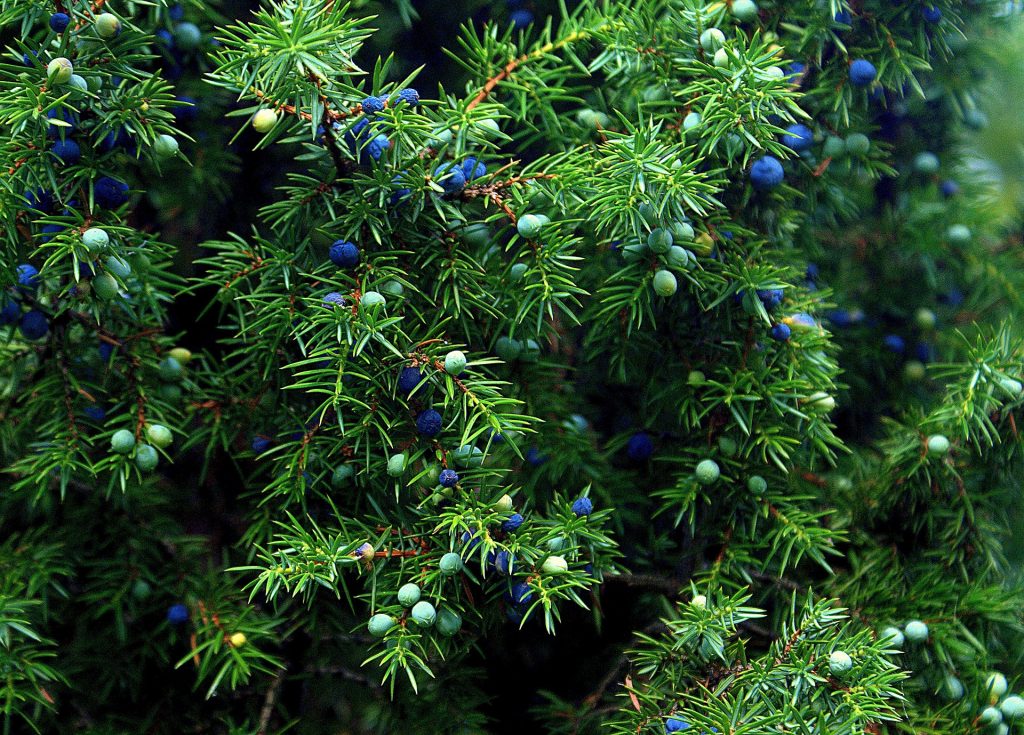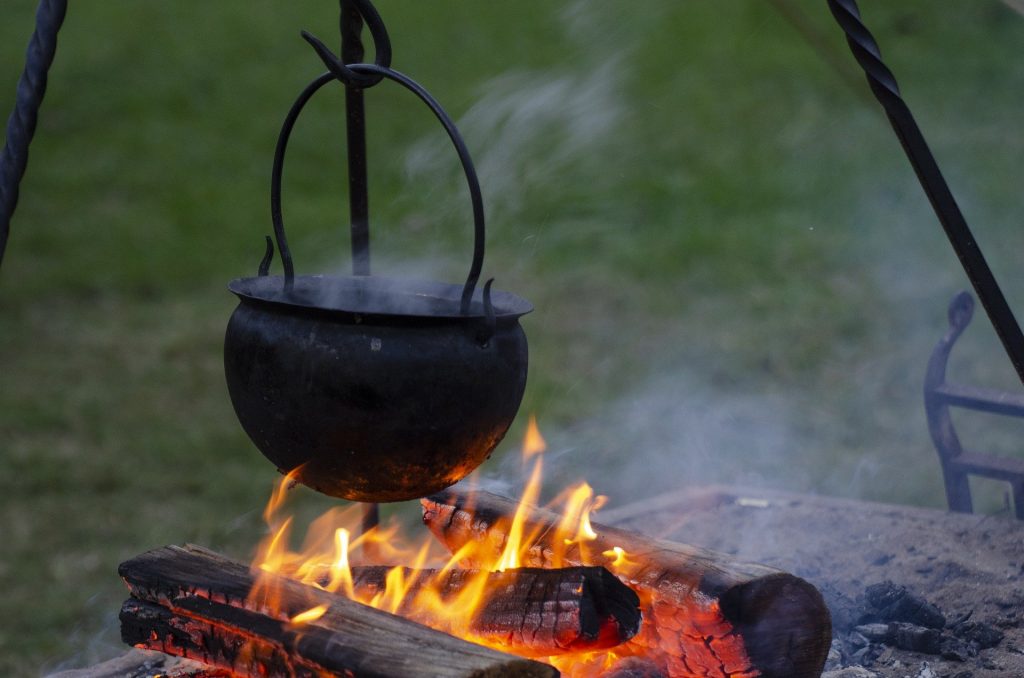
Researching for this blog I opened a veritable Pandora's box of folklore. Apparently juniper could be used for anything from protecting your home from thieves and witches, treating burns and even a vaginal douche. Oh, and making Gin of course.
It is my job to distill the stories to the very spirit of what this seemingly powerful plant meant to our ancestors and indeed still means to many people today. This is no mean feat, as Juniper turns out to be one of the most widespread shrubs in the Northern Hemisphere, being found from the arctic tundra in the North, right to the edge of the tropics in the South, and everywhere in between.
Juniper wood burns with a moderate amount of strong smelling smoke, excellent for adding flavour to your barbeque, but also perfect for purification, detering evil spirits, aiding clairvoyance and even bridging the gap between here and the underworld.

In Scotland Juniper would be burned ritually at times of ‘Saining’ or blessing, such as hogmanay. The smoke would not only purify and cleanse, but bless and protect the household and its inhabitants.
Juniper didn’t need to be burnt to offer it’s protection. In mediterranean regions people believed that by simply growing a plant near the entrance to your house or even hanging boughs over the doorway you could deter witches from entering your abode. Apparently they would be compelled to count all the needles of the tree, which obviously took such a long time they would soon give up.
Being a tree of protection seems to be ubiquitous in folklore across Europe and the Middle East. This probably stems from the Bible, where it is mentioned at least once as a tree of protection. In the Old Testament Book of Kings it is the tree that Elijah hid under when escaping the wrath of Jezebel.
It seems that Elijah got a bit cocky when he beat the Queens prophets of the God Baal in a game of burn the sacrifice. When Elijah had these (un)holy men killed, Jezebel got a bit annoyed and vowed to make Elijah like them, ie. dead. Elijah scarpered and hid under a Juniper Bush. Apparently he wasn’t very happy with the situation and prayed for death (why he didn’t just let Jez do it I don’t know). Instead an angel of God came to him with a cup of tea and biscuit (or the biblical equivalent), and told him to continue doing God's work.
Although not directly mentioned in the New Testament, Juniper also crops up in legend surrounding the Christmas story. Apparently, Mary and Joseph had had Jesus, and were warned by the wise men of King Herrod’s plans to commit a bit of infantiside. Being pursued by Herod's soldiers, the Donkey was running at full gallop with the entire holy family (and presumably Jesus’s new sheep and his Gold, Frankincense and Myrrh) on his back. Not surprisingly he was knackered. Luckily there was a giant Juniper tree that opened up it’s boughs, hiding and protecting them.

Just one look at a Juniper bush and it’s thick coverage of needly branches makes it obvious why it makes such a good hiding pace from angry biblical monarchs, and this is why across Europe and America you will see Juniper hung up with bright red ribbons (Jesus’ blood) over the entrances to stables and barns at Christmas time.
The Brothers Grimm have a rather gruesome and, well, grim fairy tale called ‘The Juniper Tree’ concerning a wicked stepmother, a juniper tree and a spot of cannibalism. A rich couple are desperate for a child. The woman prays under a juniper tree and is soon found to be pregnant. Unfortunately she dies in childbirth, but her son survives. Her final request is that she is buried under the Juniper tree.
The husband remarries and has a second child, a daughter and everything seems ok. Obviously the wicked stepmother hates the boy, so tricks him into getting an apple from a box that she uses to chop his head off. She then reattaches the head to the boy's body and pretends that he is sleeping so that the sister accidentally knocks it off and blames herself.
The stepmother then decides the best thing to do is to chop the boy up and cook him in a stew which she serves to her husband. “Yum Yum he says, can I have some more? By the way, have you seen my son?”

A white dove that lives in the juniper tree has witnessed the whole thing. The dove flies first to a jeweler, singing a song telling of what happened. The jeweller pays the dove with a gold chain. The Dove does the same for a cobbler and a miller, getting paid in shoes and a mill stone respectively.
The Dove then flies back to the house and drops the gold chain at the feet of the man, the shoes to the daughter and the mill stone on the head of the wicked stepmother.
Purification wasn’t limited to the wood, tree or the smoke. The berries, which are actually a form of pine cone in disguise, have been used medicinally throughout history. An ancient Egyptian papyrus from as far back as 1500BC notes their use in a cure to tapeworm, The Romans used it for stomach ailments, and the medieval herbalist Culpeper recommended Juniper to ward off flatulence.
Whilst there has been little scientific study, and therefore little evidence to suggest that Juniper is a useful medicine, it has been shown to affect the uterus, and it is advised that pregnant women should avoid juniper. In fact Juniper has been used across Europe and Asia to aid contractions in labour, and also as a way to induce miscarriages as a form of abortion. This could be where the phrase ‘Mother’s Ruin’ comes from.
Fans of Hogarth’s 1751 engraving, ‘Gin Lane’ might convincingly argue that the phrase ‘mothers ruin’ more aptly applies to the effects of prolonged interaction with the spirit. Especially when attention is brought to the woman in the foreground who seems to care more about her watch than the baby who is falling into the river.
Although Gin is said to have been invented in the 17th Century by Dutch physician Franciscus Sylvious at the time hundreds of dutch and flemish distilleries where creating their own spirits, flavoured with all sorts of berries and spices, from cardamom, caraway and coriander to, well pretty much anything you can think of, including Juniper. Monasteries had been producing strong alcohol for hundreds of years and using them as a way to extract and administer the medicinal qualities of herbs and berries.
During the 30 year war (1618 - 1648) soldiers would routinely take ‘genever’ (Dutch Gin) as a medicine, and especially to instil bravery before battle, and so the term Dutch Courage was born. When the war was over and with the later ascension to the throne of the Dutch king William of Orange in 1689 Gin became very popular in England and Wales.

A lack of taxation (as opposed to the heavily taxed wines and cognacs of France) and the increase in popularity of a less sophisticated and cheaper ‘home distilled’ version soon led to ‘the Gin Craze’ and scenes like ‘Gin Lane’ were commonplace.
Things got so bad that stories like that of Judith DeFour from Spitalfield, London didn’t even make the headlines. In 1734 DeFour and her friend Sukey took her two year old daughter Mary DeFour to a field where they proceeded to remove all of her clothes and abandon her in a ditch. The poor girl died alone while the two women sold the clothes for a quart of Gin and were hanged soon after.
The Gin Act of 1751 combined with a strong propaganda campaign (including Hogarth's etchings) promoting Beer and Tea over the consumption of Gin soon started to curb the nation's thirst for the spirit. By 1830 Beer finally became cheaper than Gin for the first time in over 100 years.
In fact Gin was so unpopular in the mid Victorian era that it took Malaria to repopularlise it. Having sobered up, Britain had expanded her empire across the world, often to the tropics where the disease was rife. In order to combat the illness the British Royal Navy rationed Quinine to her sailors. Unfortunately Quinine tastes rank. Luckily the company Schweppes was on hand to create a drink out of the vile stuff that was actually quite nice. They called it Indian Tonic Water.
Beer takes up a lot of space on boats and doesn’t travel well. By now the Navy were a bit bored with Rum so Gin was the fashionable thing to drink on board. It wasn’t long before these two products were combined with a squeeze of anti scurvy Lime to create the classic cocktail Gin and Tonic.

Plymouth Gin was so popular in the Navy that during the second world war, when Hitler bombed the naval dockyard there, also destroying the distillery, one sailor is reported to have said “Well, Hitler has just lost the war. Bombing London was bad enough, but attacking the home of the Navy and their Gin is unacceptable.”
Today gin has a bit of a cult following, with hundreds of small distilleries, not only in the UK, but world wide too. But Gin isn’t the only way that the wonderful flavour of the Juniper berry can be enjoyed. Coinciding with the game season, the fruit can be made into delicious sauces and jellies that go oh so well with pheasant, partridge and venison.
If you want to have a go at creating your own gin but don’t happen to have a distillery, then you can simply infuse your foraged Juniper berries along with herbs and spices of our choice into Vodka.
In the mean time, why not try this simple recipe for my fantastic Festive Juniper Sausage Rolls? It comes straight from the pages of our fantastic new book, Foraging Fairy-tales: Hedgerow Festival, where you will also find plenty more delightful stories like the one you've just read. While you're waiting for that to be delivered, you could read this Cheeky Cherry Chapter.